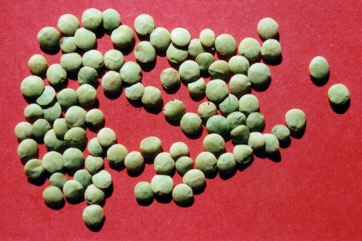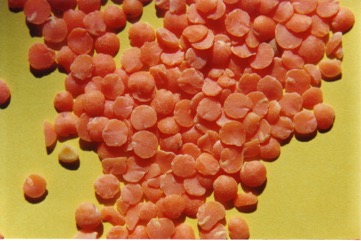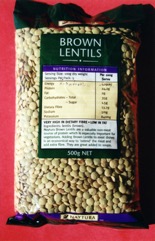Lentils

A plant of warm temperate and tropical zones. It prefers a sandy soil in a warm position. It produces most seed when grown on poorer soils. They grow in subtropical, warm temperate and high altitude tropical places. In India they grow from sea level to 3,500 m altitude. In Nepal they grow to about 1000 m altitude. In Ethiopia it grows between 1,600-2,350 m above sea level. They can grow on a range of soils. It suits hardiness zones 7-11. In Yunnan.
Also known as:
Aoi mame, Bagali, Bing dou, Chanangi, Chirisanagalu, Dhal, Kacang koro, Kacang serinding, Kursam bulle pullie, Lente, Lenteja, Lenticchia, Lentilha, Lentille, Lentja, Linse, Malka masur, Masar, Masser, Masur, Masuri, Masurmoha, Masuro, Misurpappu, Moshur, Musri, Navadna leča, Patani, Pe ni, Pe-ni-ale, Pesan-ban, Pe-yaza, Pothundhambala, Red Dahl, Sai min dou, Thietdau, Thua daeng, Thua raatcha maat
Synonyms
- Cicer lens (L.) Willd.
- Ervum lens L.
- Lens esculenta Moench
- Lentilla lens (L.) W. Wight ex D. Fairchild
- Lens ervoides (Brign.) Grande
- Lens nigricans
- Vicia lens (L.) Cosson & Germ.
Edible Portion
- Seeds, Pods, Vegetable
Where does Lentils grow?
Found in: Afghanistan, Africa, Albania, Algeria, Angola, Argentina, Asia, Australia, Austria, Bangladesh, Belgium, Britain, Bulgaria, Canada, Caucasus, Central Europe, Central America, Chile, China, Colombia, Cuba, Czech Republic, East Africa, Ecuador, Egypt, Eritrea, Ethiopia, Europe, Fiji, France, Georgia, Germany, Greece, Guatemala, Himalayas, Hungary, India, Indochina, Indonesia, Iran, Iraq, Israel, Italy, Japan, Jordan, Kenya, Kyrgyzstan, Lebanon, Libya, Macedonia, Madagascar, Malawi, Malaysia, Mauritius, Mediterranean, Middle East, Mongolia, Morocco, Mozambique, Myanmar, Nepal, Netherlands, New Zealand, North Africa, North America, Pacific, Pakistan, Philippines, Portugal, Reunion, Romania, Saudi Arabia, SE Asia, Serbia, Slovenia, South Africa, Southern Africa, South America, Spain, Sri Lanka, Sudan, Switzerland, Syria, Tajikistan, Tanzania, Tasmania, Thailand, Tibet, Tunisia, Turkey, United States, Vietnam, Yemen, Zimbabwe
Notes: There are 4 Lens species. Biblical references: Genesis 25:29-34; 2 Samuel 17:28; Ezekiel 4:9
Status: It is a commercially cultivated vegetable. World production is about 1 million tons each year. It is an ancient crop.
Growing Lentils
Cultivation: Seed are sown where they are to grow. Plants are normally self pollinated but cross pollination can occur. In India it is often grown mixed with rice. When grown as a pure stand it can be broadcast or planted in rows.
Edible Uses: The seed are cooked or sprouted or eaten raw. Young seedpods can be cooked and eaten. The ground seed can be used with cereals. The seeds are often eaten in soups and stews. They are served as Dahl in India. Lentil flour can be mixed with cereal flour to bake bread. The sprouted seeds are eaten in salads, vegetable dishes and soups.
Production: Yields of 2 ton per hectare are possible. For sprouts the seeds are soaked for 12 hours in warm water then allowed to sprout for 5 days. Crops mature in about 3.5 months.
Nutrition Info
per 100g edible portion| Edible Part | Energy (kcal) | Protein (g) | Iron (mg) | Vitamin A (ug) | Vitamin c (mg) | Zinc (mg) | % Water |
|---|---|---|---|---|---|---|---|
| (split+boiled) | 100 | 7.6 | 2.4 | 20 | Tr | 1 | 72.1 |
| Seed sprouted cooked | 101 | 8.8 | 3.1 | 4 | 12.6 | 1.6 | 68.7 |
Lentils Photos



References
Addis, G., et al, 2005, Ethnobotanical Study of Edible Wild Plants in Some Selected Districts of Ethiopia. Human Ecology, Vol. 33, No. 1, pp. 83-118 (As Lens ervoides)
Ali, A. M. S., 2005, Homegardens in Smallholder Farming Systems: Examples from Bangladesh. Human Ecology, Vol. 33, No. 2 pp. 245-270 (As Lens esculenta)
Ambasta, S.P. (Ed.), 2000, The Useful Plants of India. CSIR India. p 322
Ara, R. I. T., 2015, Leafy Vegetables in Bangladesh. Photon eBooks. p 142 (As Lens esculenta)
Bejiga, G., 2006. Lens culinaris Medik. [Internet] Record from Protabase. Brink, M. & Belay, G. (Editors). PROTA (Plant Resources of Tropical Africa), Wageningen, Netherlands. < http://database.prota.org/search.htm>. Accessed 16 October 2009.
Bianchini, F., Corbetta, F., and Pistoia, M., 1975, Fruits of the Earth. Cassell. p 40
Brouk, B., 1975, Plants Consumed by Man. Academic Press, London. p 112
Burkill, I.H., 1966, A Dictionary of the Economic Products of the Malay Peninsula. Ministry of Agriculture and Cooperatives, Kuala Lumpur, Malaysia. Vol 2 (I-Z) p 1350 (As Lens esculenta)
Bussman, R. W. et al, 2017, Ethnobotany of Samtskhe-Javakheti, Sakartvelo (Republic of Georgia), Caucasus. Indian Journal of Traditional Knowledge Vol. 16(1) pp 7-24 (As Lens cornicularis)
Cobley, L.S. (rev. Steele, W.M.) 2nd Ed., 1976, An Introduction to the Botany of Tropical Crops. Longmans. p 98 (As Lens esculenta)
Cundall, P., (ed.), 2004, Gardening Australia: flora: the gardener's bible. ABC Books. p 805
Facciola, S., 1998, Cornucopia 2: a Source Book of Edible Plants. Kampong Publications, p 106 (As Lens esculenta)
FAO, 1988, Traditional Food Plants, FAO Food and Nutrition Paper 42. FAO Rome p 350 (As Lens esculenta)
Flora of Pakistan. www.eFloras.org
Hedrick, U.P., 1919, (Ed.), Sturtevant's edible plants of the world. p 376 (As Lens esculenta)
Hermandez Bermejo, J.E., and Leon, J. (Eds.), 1994, Neglected Crops. 1492 from a different perspective. FAO Plant Production and Protection Series No 26. FAO, Rome. p 298
http://www.botanic-gardens-ljubljana.com/en/plants
Hu, Shiu-ying, 2005, Food Plants of China. The Chinese University Press. p 476
Jardin, C., 1970, List of Foods Used In Africa, FAO Nutrition Information Document Series No 2.p 25
Kays, S. J., and Dias, J. C. S., 1995, Common Names of Commercially Cultivated Vegetables of the World in 15 languages. Economic Botany, Vol. 49, No. 2, pp. 115-152
Kiple, K.F. & Ornelas, K.C., (eds), 2000, The Cambridge World History of Food. CUP p 1801 (As Lens esculenta)
Macmillan, H.F. (Revised Barlow, H.S., et al) 1991, Tropical Planting and Gardening. Sixth edition. Malayan Nature Society. Kuala Lumpur. p 325
Manandhar, N.P., 2002, Plants and People of Nepal. Timber Press. Portland, Oregon. p 289
Menninger, E.A., 1977, Edible Nuts of the World. Horticultural Books. Florida p 96 (As Lens esculenta)
Moerman, D. F., 2010, Native American Ethnobotany. Timber Press. p 301
Molares, S. & Ladio, A., 2012, The Usefulness of Edible and Medicinal Fabaceae in Argentine and Chilean Patagonia: Environmental Availability and Other Sources of Supply. Evidence-Based Complementary and Alternative Medicine. Volume 2012, Article ID 901918, 12 pages, Hindawi Publishing Corporation.
Molla, A., Ethiopian Plant Names. http://www.ethiopic.com/aplants.htm (As Lens ervoides and Lens esculenta)
Pham-Hoang Ho, 1999, An Illustrated Flora of Vietnam. Nha Xuat Ban Tre. p 978
Plants for a Future database, The Field, Penpol, Lostwithiel, Cornwall, PL22 0NG, UK. http://www.scs.leeds.ac.uk/pfaf/
Plants for a Future database, The Field, Penpol, Lostwithiel, Cornwall, PL22 0NG, UK. http://www.scs.leeds.ac.uk/pfaf/ (As Lens ervoides)
Polunin, O., & Stainton, A., 2006, Flowers of the Himalaya, Oxford India Paperbacks. p 101
Purseglove, J.W., 1968, Tropical Crops Dicotyledons, Longmans. p 279 (As Lens esculenta)
Rashid, H. E., 1977, Geography of Bangladesh. Westview. p 252 (As Lens esculenta)
Ruiters-Welcome, A. K., 2019, Food plants of southern Africa. Ph.D. thesis. Univ. of Johannesburg p 58
Small, E., 2009, Top 100 Food Plants. The world's most important culinary crops. NRC Research Press. p 314
Solomon, C., 2001, Encyclopedia of Asian Food. New Holland. p 210
Tardio, J., et al, Ethnobotanical review of wild edible plants in Spain. Botanical J. Linnean Soc. 152 (2006), 27-71 (As Lens esculenta)
USDA, ARS, National Genetic Resources Program. Germplasm Resources Information Network - (GRIN). [Online Database] National Germplasm Resources Laboratory, Beltsville, Maryland. Available: www.ars-grin.gov/cgi-bin/npgs/html/econ.pl (10 April 2000)
van Wyk, B., 2005, Food Plants of the World. An illustrated guide. Timber press. p 226
Vickery, M.L. and Vickery, B., 1979, Plant Products of Tropical Africa, Macmillan. p 24 (As Lens esculenta)
Vorles. Churpfaulz. Phys.-oukon. Ges. 2:361. 1787
Williamson, J., 2005, Useful Plants of Malawi. 3rd. Edition. Mdadzi Book Trust. p 153
Wilson, J.M. & Witcombe, J.R., Crops for Arid lands, in Wickens, G.E., Goodin, J.R., and Field, D.V.,(Eds.) 1985, Plants for Arid Lands. Unwin Hyman, London, p 40
World Checklist of Useful Plant Species 2020. Royal Botanic Gardens, Kew
Zohary, D., 1979, Lentil, in Simmonds N.W.,(ed), Crop Plant Evolution. Longmans. London. p 163